Analyzing the Fear of Crime: Causes, Prevention, and Social Factors
VerifiedAdded on 2022/12/19
|6
|1515
|28
Essay
AI Summary
This essay explores the multifaceted concept of the fear of crime, examining its measurement through various methods like the Uniform Crime Report (UCR) and the National Crime Victimization Survey (NCVS). It delves into the causes of this fear, noting the influence of factors like ethnicity and gender. The essay further analyzes different crime prevention models, including situational, developmental, and community-based approaches, and their effectiveness in reducing crime rates and mitigating the fear of crime. The analysis also includes the importance of primary, secondary, and tertiary prevention strategies and how they can be implemented to ensure safety and security in society.

Running head: THE FEAR OF CRIME 1
The Fear of Crime
Student’s Name
Institution
The Fear of Crime
Student’s Name
Institution
Paraphrase This Document
Need a fresh take? Get an instant paraphrase of this document with our AI Paraphraser
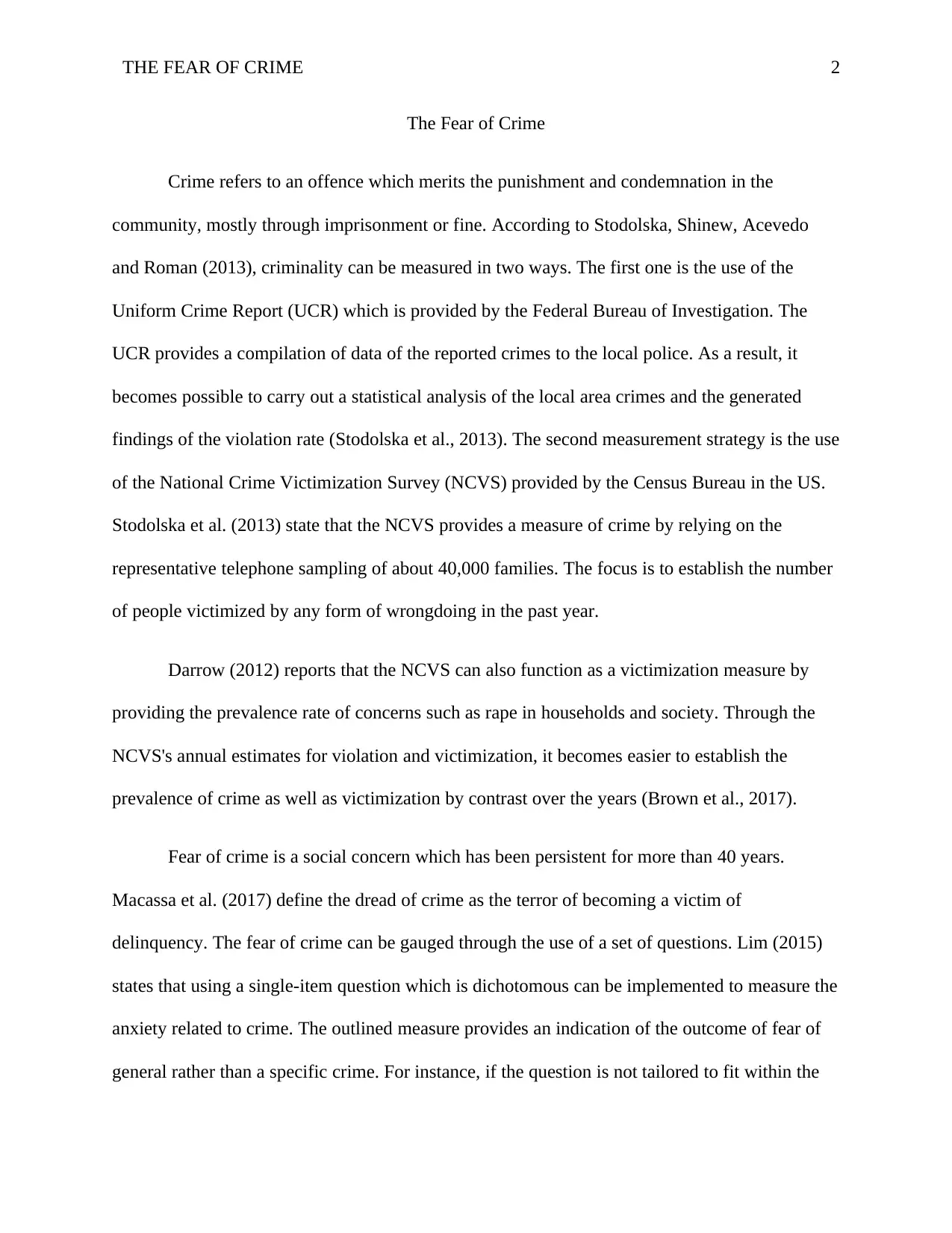
THE FEAR OF CRIME 2
The Fear of Crime
Crime refers to an offence which merits the punishment and condemnation in the
community, mostly through imprisonment or fine. According to Stodolska, Shinew, Acevedo
and Roman (2013), criminality can be measured in two ways. The first one is the use of the
Uniform Crime Report (UCR) which is provided by the Federal Bureau of Investigation. The
UCR provides a compilation of data of the reported crimes to the local police. As a result, it
becomes possible to carry out a statistical analysis of the local area crimes and the generated
findings of the violation rate (Stodolska et al., 2013). The second measurement strategy is the use
of the National Crime Victimization Survey (NCVS) provided by the Census Bureau in the US.
Stodolska et al. (2013) state that the NCVS provides a measure of crime by relying on the
representative telephone sampling of about 40,000 families. The focus is to establish the number
of people victimized by any form of wrongdoing in the past year.
Darrow (2012) reports that the NCVS can also function as a victimization measure by
providing the prevalence rate of concerns such as rape in households and society. Through the
NCVS's annual estimates for violation and victimization, it becomes easier to establish the
prevalence of crime as well as victimization by contrast over the years (Brown et al., 2017).
Fear of crime is a social concern which has been persistent for more than 40 years.
Macassa et al. (2017) define the dread of crime as the terror of becoming a victim of
delinquency. The fear of crime can be gauged through the use of a set of questions. Lim (2015)
states that using a single-item question which is dichotomous can be implemented to measure the
anxiety related to crime. The outlined measure provides an indication of the outcome of fear of
general rather than a specific crime. For instance, if the question is not tailored to fit within the
The Fear of Crime
Crime refers to an offence which merits the punishment and condemnation in the
community, mostly through imprisonment or fine. According to Stodolska, Shinew, Acevedo
and Roman (2013), criminality can be measured in two ways. The first one is the use of the
Uniform Crime Report (UCR) which is provided by the Federal Bureau of Investigation. The
UCR provides a compilation of data of the reported crimes to the local police. As a result, it
becomes possible to carry out a statistical analysis of the local area crimes and the generated
findings of the violation rate (Stodolska et al., 2013). The second measurement strategy is the use
of the National Crime Victimization Survey (NCVS) provided by the Census Bureau in the US.
Stodolska et al. (2013) state that the NCVS provides a measure of crime by relying on the
representative telephone sampling of about 40,000 families. The focus is to establish the number
of people victimized by any form of wrongdoing in the past year.
Darrow (2012) reports that the NCVS can also function as a victimization measure by
providing the prevalence rate of concerns such as rape in households and society. Through the
NCVS's annual estimates for violation and victimization, it becomes easier to establish the
prevalence of crime as well as victimization by contrast over the years (Brown et al., 2017).
Fear of crime is a social concern which has been persistent for more than 40 years.
Macassa et al. (2017) define the dread of crime as the terror of becoming a victim of
delinquency. The fear of crime can be gauged through the use of a set of questions. Lim (2015)
states that using a single-item question which is dichotomous can be implemented to measure the
anxiety related to crime. The outlined measure provides an indication of the outcome of fear of
general rather than a specific crime. For instance, if the question is not tailored to fit within the
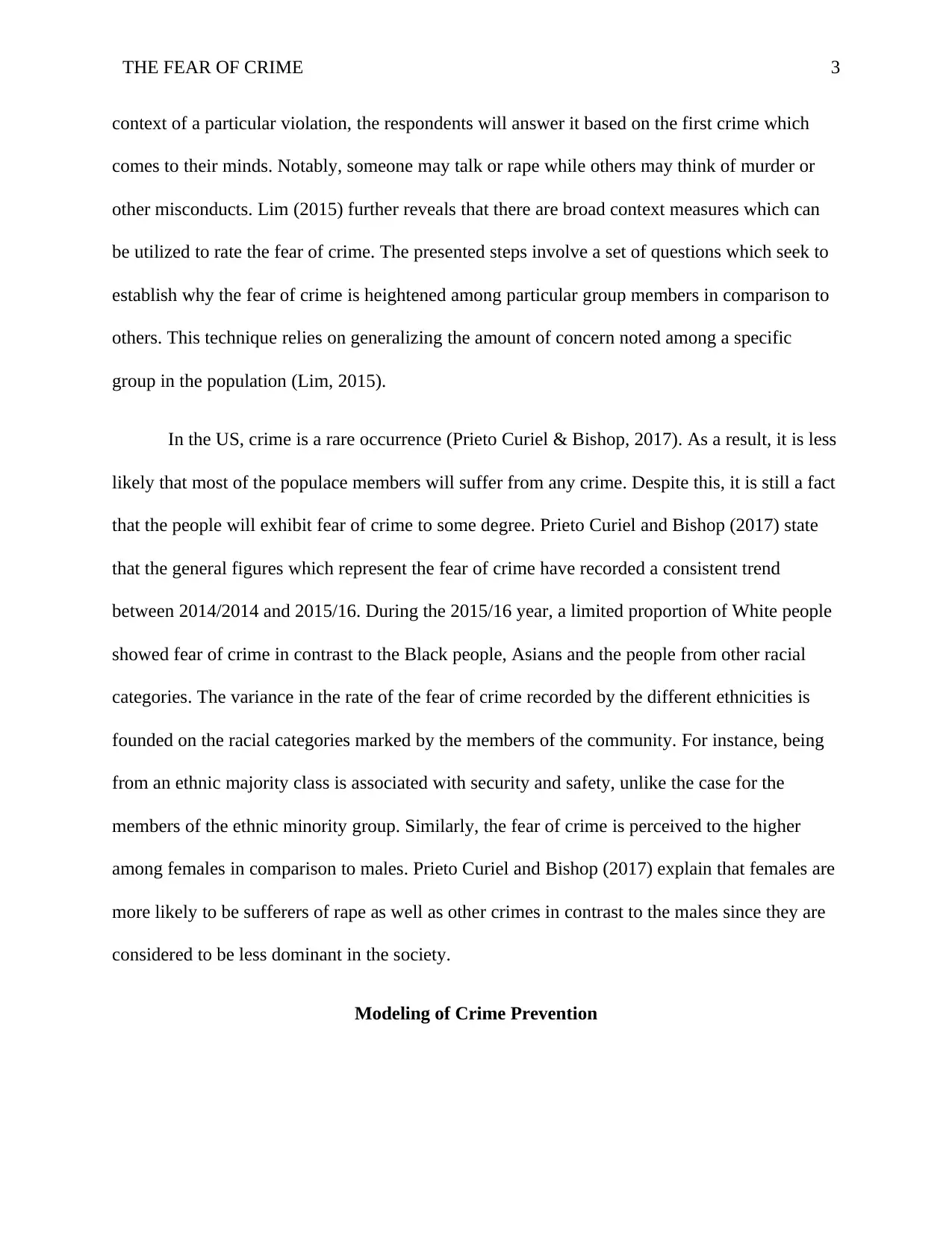
THE FEAR OF CRIME 3
context of a particular violation, the respondents will answer it based on the first crime which
comes to their minds. Notably, someone may talk or rape while others may think of murder or
other misconducts. Lim (2015) further reveals that there are broad context measures which can
be utilized to rate the fear of crime. The presented steps involve a set of questions which seek to
establish why the fear of crime is heightened among particular group members in comparison to
others. This technique relies on generalizing the amount of concern noted among a specific
group in the population (Lim, 2015).
In the US, crime is a rare occurrence (Prieto Curiel & Bishop, 2017). As a result, it is less
likely that most of the populace members will suffer from any crime. Despite this, it is still a fact
that the people will exhibit fear of crime to some degree. Prieto Curiel and Bishop (2017) state
that the general figures which represent the fear of crime have recorded a consistent trend
between 2014/2014 and 2015/16. During the 2015/16 year, a limited proportion of White people
showed fear of crime in contrast to the Black people, Asians and the people from other racial
categories. The variance in the rate of the fear of crime recorded by the different ethnicities is
founded on the racial categories marked by the members of the community. For instance, being
from an ethnic majority class is associated with security and safety, unlike the case for the
members of the ethnic minority group. Similarly, the fear of crime is perceived to the higher
among females in comparison to males. Prieto Curiel and Bishop (2017) explain that females are
more likely to be sufferers of rape as well as other crimes in contrast to the males since they are
considered to be less dominant in the society.
Modeling of Crime Prevention
context of a particular violation, the respondents will answer it based on the first crime which
comes to their minds. Notably, someone may talk or rape while others may think of murder or
other misconducts. Lim (2015) further reveals that there are broad context measures which can
be utilized to rate the fear of crime. The presented steps involve a set of questions which seek to
establish why the fear of crime is heightened among particular group members in comparison to
others. This technique relies on generalizing the amount of concern noted among a specific
group in the population (Lim, 2015).
In the US, crime is a rare occurrence (Prieto Curiel & Bishop, 2017). As a result, it is less
likely that most of the populace members will suffer from any crime. Despite this, it is still a fact
that the people will exhibit fear of crime to some degree. Prieto Curiel and Bishop (2017) state
that the general figures which represent the fear of crime have recorded a consistent trend
between 2014/2014 and 2015/16. During the 2015/16 year, a limited proportion of White people
showed fear of crime in contrast to the Black people, Asians and the people from other racial
categories. The variance in the rate of the fear of crime recorded by the different ethnicities is
founded on the racial categories marked by the members of the community. For instance, being
from an ethnic majority class is associated with security and safety, unlike the case for the
members of the ethnic minority group. Similarly, the fear of crime is perceived to the higher
among females in comparison to males. Prieto Curiel and Bishop (2017) explain that females are
more likely to be sufferers of rape as well as other crimes in contrast to the males since they are
considered to be less dominant in the society.
Modeling of Crime Prevention
⊘ This is a preview!⊘
Do you want full access?
Subscribe today to unlock all pages.

Trusted by 1+ million students worldwide
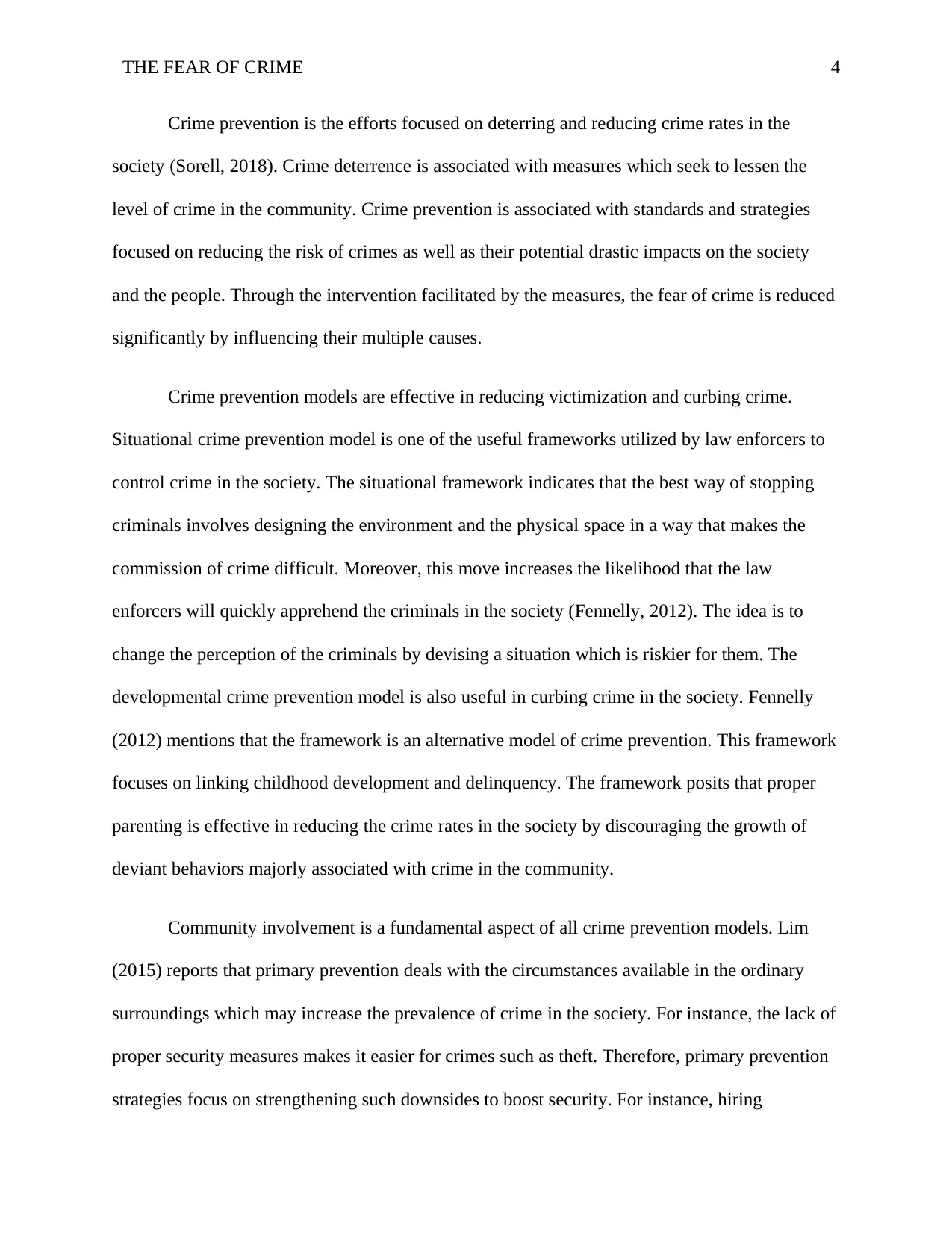
THE FEAR OF CRIME 4
Crime prevention is the efforts focused on deterring and reducing crime rates in the
society (Sorell, 2018). Crime deterrence is associated with measures which seek to lessen the
level of crime in the community. Crime prevention is associated with standards and strategies
focused on reducing the risk of crimes as well as their potential drastic impacts on the society
and the people. Through the intervention facilitated by the measures, the fear of crime is reduced
significantly by influencing their multiple causes.
Crime prevention models are effective in reducing victimization and curbing crime.
Situational crime prevention model is one of the useful frameworks utilized by law enforcers to
control crime in the society. The situational framework indicates that the best way of stopping
criminals involves designing the environment and the physical space in a way that makes the
commission of crime difficult. Moreover, this move increases the likelihood that the law
enforcers will quickly apprehend the criminals in the society (Fennelly, 2012). The idea is to
change the perception of the criminals by devising a situation which is riskier for them. The
developmental crime prevention model is also useful in curbing crime in the society. Fennelly
(2012) mentions that the framework is an alternative model of crime prevention. This framework
focuses on linking childhood development and delinquency. The framework posits that proper
parenting is effective in reducing the crime rates in the society by discouraging the growth of
deviant behaviors majorly associated with crime in the community.
Community involvement is a fundamental aspect of all crime prevention models. Lim
(2015) reports that primary prevention deals with the circumstances available in the ordinary
surroundings which may increase the prevalence of crime in the society. For instance, the lack of
proper security measures makes it easier for crimes such as theft. Therefore, primary prevention
strategies focus on strengthening such downsides to boost security. For instance, hiring
Crime prevention is the efforts focused on deterring and reducing crime rates in the
society (Sorell, 2018). Crime deterrence is associated with measures which seek to lessen the
level of crime in the community. Crime prevention is associated with standards and strategies
focused on reducing the risk of crimes as well as their potential drastic impacts on the society
and the people. Through the intervention facilitated by the measures, the fear of crime is reduced
significantly by influencing their multiple causes.
Crime prevention models are effective in reducing victimization and curbing crime.
Situational crime prevention model is one of the useful frameworks utilized by law enforcers to
control crime in the society. The situational framework indicates that the best way of stopping
criminals involves designing the environment and the physical space in a way that makes the
commission of crime difficult. Moreover, this move increases the likelihood that the law
enforcers will quickly apprehend the criminals in the society (Fennelly, 2012). The idea is to
change the perception of the criminals by devising a situation which is riskier for them. The
developmental crime prevention model is also useful in curbing crime in the society. Fennelly
(2012) mentions that the framework is an alternative model of crime prevention. This framework
focuses on linking childhood development and delinquency. The framework posits that proper
parenting is effective in reducing the crime rates in the society by discouraging the growth of
deviant behaviors majorly associated with crime in the community.
Community involvement is a fundamental aspect of all crime prevention models. Lim
(2015) reports that primary prevention deals with the circumstances available in the ordinary
surroundings which may increase the prevalence of crime in the society. For instance, the lack of
proper security measures makes it easier for crimes such as theft. Therefore, primary prevention
strategies focus on strengthening such downsides to boost security. For instance, hiring
Paraphrase This Document
Need a fresh take? Get an instant paraphrase of this document with our AI Paraphraser
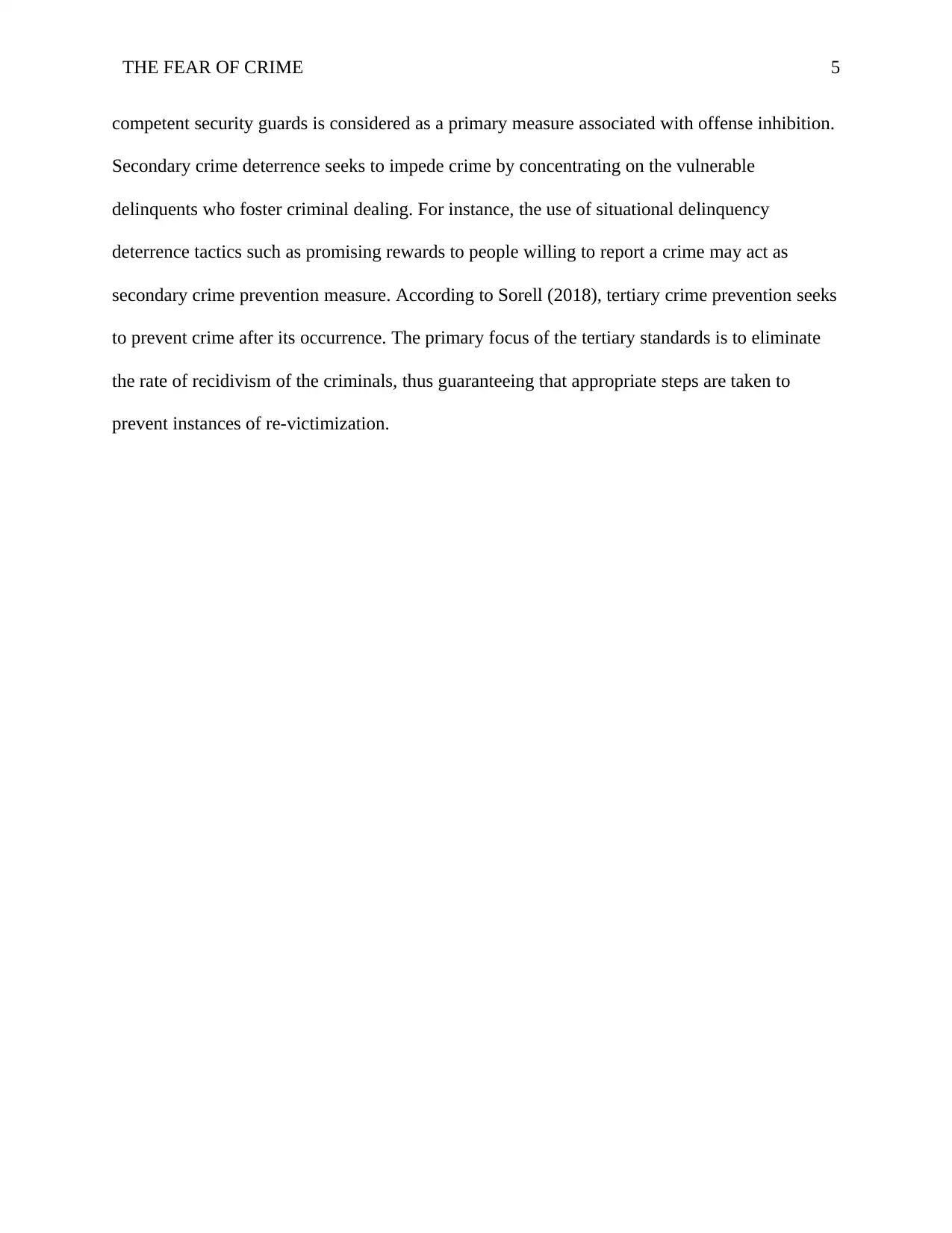
THE FEAR OF CRIME 5
competent security guards is considered as a primary measure associated with offense inhibition.
Secondary crime deterrence seeks to impede crime by concentrating on the vulnerable
delinquents who foster criminal dealing. For instance, the use of situational delinquency
deterrence tactics such as promising rewards to people willing to report a crime may act as
secondary crime prevention measure. According to Sorell (2018), tertiary crime prevention seeks
to prevent crime after its occurrence. The primary focus of the tertiary standards is to eliminate
the rate of recidivism of the criminals, thus guaranteeing that appropriate steps are taken to
prevent instances of re-victimization.
competent security guards is considered as a primary measure associated with offense inhibition.
Secondary crime deterrence seeks to impede crime by concentrating on the vulnerable
delinquents who foster criminal dealing. For instance, the use of situational delinquency
deterrence tactics such as promising rewards to people willing to report a crime may act as
secondary crime prevention measure. According to Sorell (2018), tertiary crime prevention seeks
to prevent crime after its occurrence. The primary focus of the tertiary standards is to eliminate
the rate of recidivism of the criminals, thus guaranteeing that appropriate steps are taken to
prevent instances of re-victimization.
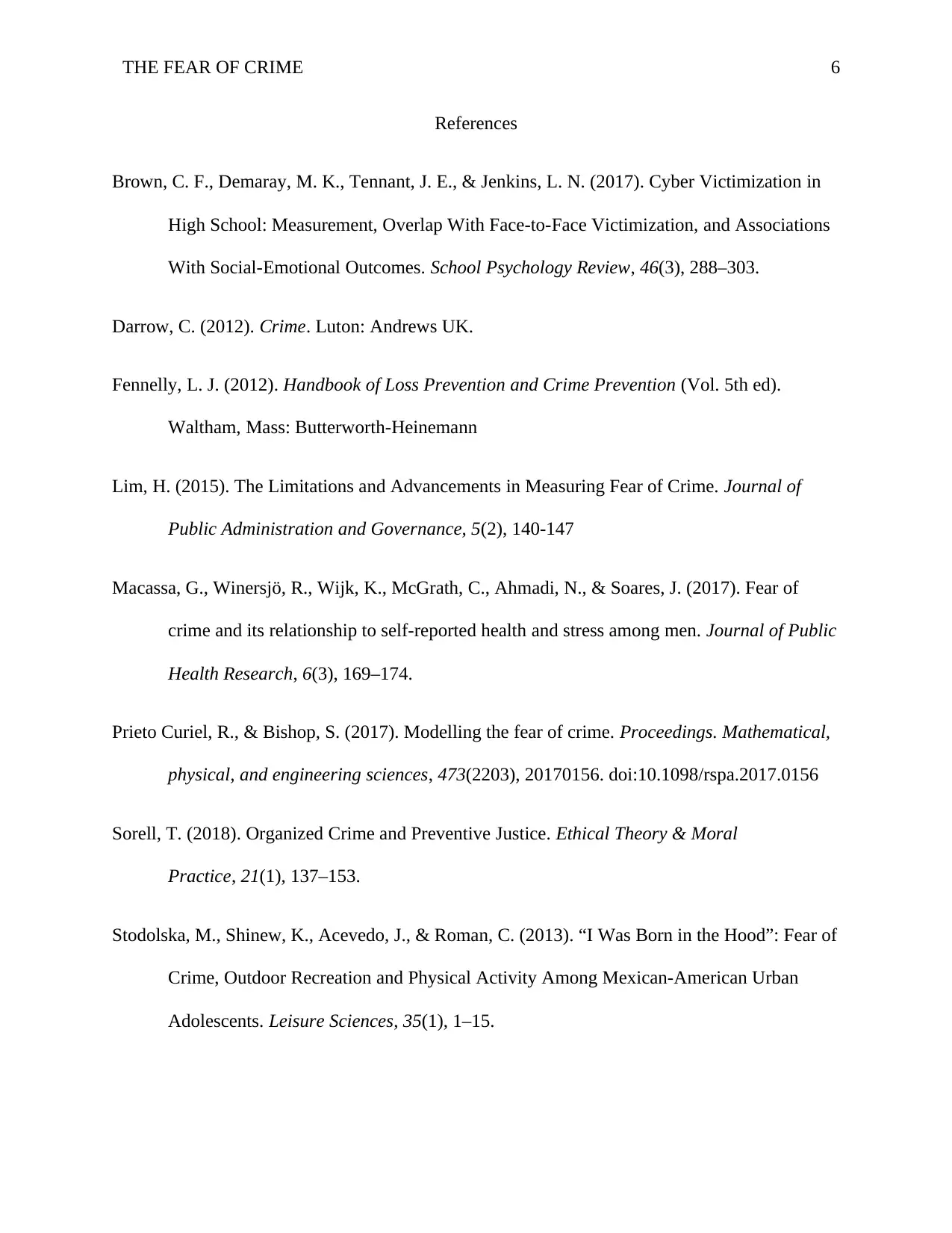
THE FEAR OF CRIME 6
References
Brown, C. F., Demaray, M. K., Tennant, J. E., & Jenkins, L. N. (2017). Cyber Victimization in
High School: Measurement, Overlap With Face-to-Face Victimization, and Associations
With Social-Emotional Outcomes. School Psychology Review, 46(3), 288–303.
Darrow, C. (2012). Crime. Luton: Andrews UK.
Fennelly, L. J. (2012). Handbook of Loss Prevention and Crime Prevention (Vol. 5th ed).
Waltham, Mass: Butterworth-Heinemann
Lim, H. (2015). The Limitations and Advancements in Measuring Fear of Crime. Journal of
Public Administration and Governance, 5(2), 140-147
Macassa, G., Winersjö, R., Wijk, K., McGrath, C., Ahmadi, N., & Soares, J. (2017). Fear of
crime and its relationship to self-reported health and stress among men. Journal of Public
Health Research, 6(3), 169–174.
Prieto Curiel, R., & Bishop, S. (2017). Modelling the fear of crime. Proceedings. Mathematical,
physical, and engineering sciences, 473(2203), 20170156. doi:10.1098/rspa.2017.0156
Sorell, T. (2018). Organized Crime and Preventive Justice. Ethical Theory & Moral
Practice, 21(1), 137–153.
Stodolska, M., Shinew, K., Acevedo, J., & Roman, C. (2013). “I Was Born in the Hood”: Fear of
Crime, Outdoor Recreation and Physical Activity Among Mexican-American Urban
Adolescents. Leisure Sciences, 35(1), 1–15.
References
Brown, C. F., Demaray, M. K., Tennant, J. E., & Jenkins, L. N. (2017). Cyber Victimization in
High School: Measurement, Overlap With Face-to-Face Victimization, and Associations
With Social-Emotional Outcomes. School Psychology Review, 46(3), 288–303.
Darrow, C. (2012). Crime. Luton: Andrews UK.
Fennelly, L. J. (2012). Handbook of Loss Prevention and Crime Prevention (Vol. 5th ed).
Waltham, Mass: Butterworth-Heinemann
Lim, H. (2015). The Limitations and Advancements in Measuring Fear of Crime. Journal of
Public Administration and Governance, 5(2), 140-147
Macassa, G., Winersjö, R., Wijk, K., McGrath, C., Ahmadi, N., & Soares, J. (2017). Fear of
crime and its relationship to self-reported health and stress among men. Journal of Public
Health Research, 6(3), 169–174.
Prieto Curiel, R., & Bishop, S. (2017). Modelling the fear of crime. Proceedings. Mathematical,
physical, and engineering sciences, 473(2203), 20170156. doi:10.1098/rspa.2017.0156
Sorell, T. (2018). Organized Crime and Preventive Justice. Ethical Theory & Moral
Practice, 21(1), 137–153.
Stodolska, M., Shinew, K., Acevedo, J., & Roman, C. (2013). “I Was Born in the Hood”: Fear of
Crime, Outdoor Recreation and Physical Activity Among Mexican-American Urban
Adolescents. Leisure Sciences, 35(1), 1–15.
⊘ This is a preview!⊘
Do you want full access?
Subscribe today to unlock all pages.

Trusted by 1+ million students worldwide
1 out of 6
Related Documents
Your All-in-One AI-Powered Toolkit for Academic Success.
+13062052269
info@desklib.com
Available 24*7 on WhatsApp / Email
![[object Object]](/_next/static/media/star-bottom.7253800d.svg)
Unlock your academic potential
Copyright © 2020–2025 A2Z Services. All Rights Reserved. Developed and managed by ZUCOL.





